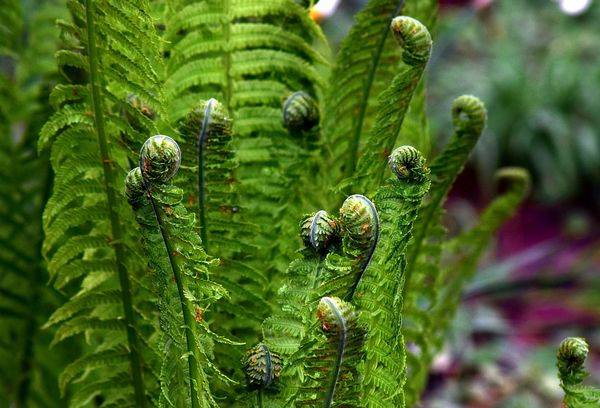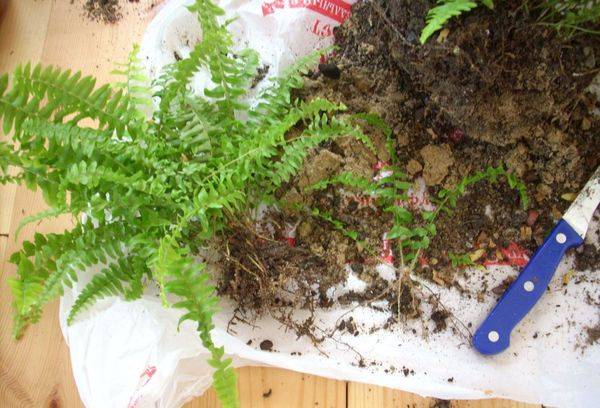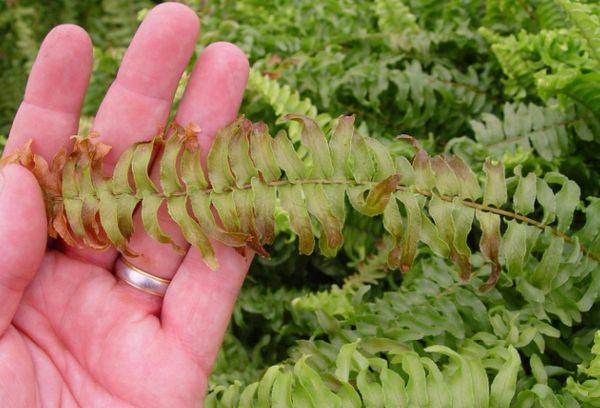Fountain of green leaves: how to care for fern nephrolepis
Content:
With the help of some plants, you can not only decorate the interior, but also improve the space around you. One of these green helpers is fern nephrolepis. Caring for it is quite simple: just place the flowerpot in comfortable conditions and control the flow of moisture. Nephrolepis absorbs harmful fumes, so it is often chosen to decorate not only apartments and offices, but also hospitals.
Description
Nephrolepis (lat. Nephrolepis) is common in tropical and subtropical forests of Southeast Asia, as well as in Africa, North America and Australia. The name comes from the Greek words “nephros”, which means “kidney,” and “lepis,” which translates as “scales." It is not entirely correct to call nephrolepis a flower: this plant is a fern. As you know, they do not bloom and multiply by spores, not seeds.
Nephrolepis is an actively growing perennial, reaching a height of 1 m or more, but dwarf varieties are also found. The plant is a lush rosette of light green leaves growing directly from the rhizome and having a dissected shape resembling feathers. Apical leaf growth often lasts several years. Ferns prefer a secluded areola in the shade of tall trees, and few choose open spaces. This feature should be considered when growing nephrolepis at home.

Fern Green Lady
Fern is valued not only for the high decorativeness of cirrus leaves. The plant is known for its disinfecting effect: it easily absorbs toxic substances such as formaldehyde. Nephrolepis is grown in hospitals because of its ability to destroy harmful microbes that sick people exhale. At home, the plant purifies the air, helps fight diseases, accelerates recovery.
Nephrolepis is an unpretentious plant, it is easily grown indoors. In floriculture, this fern has gained great popularity, unlike other similar plants. The fact is that nephrolepis extremely rarely causes allergic reactions, while other ferns are often toxic. Therefore, lovers of these lush branchy plants are hunting for varieties of nephrolepis.
Varieties
There are about 30-40 types of nephrolepis. They are distributed around the globe. Thanks to the activities of breeders, many varieties have appeared that differ in the size and shape of the leaves. Here are a few representatives:
- Nephrolepis is elevated. This species has a short rhizome, from which a rosette of light green leaves grows up to 50 cm long. They are curved and cut across in the form of feathers.
- Boston, or Boston - a grade of elevated nephrolepis. Its decorative leaflets are highly valued: they are wavy, repeatedly dissected.
- Cardiac Nephrolepis - The owner of unusual erect leaves. Their segments are rounded and overlap each other. View is used to make bouquets.
- Emina - compact undersized fern with curly leaves. The edge of the plate is carved.
- Green lady - A view with a lush rosette of leaves crowning a rhizome.
- Xiphoid nephrolepis Suitable for growing in large rooms or greenhouses. The length of its sheet reaches 2.5 m.

Xiphoid nephrolepis
Accommodation in the house
Nephrolepis looks best in hanging planters. But in a regular flowerpot on a windowsill, a lush plant will be impressive.The pot is selected low and roomy, as the fern develops in breadth. A cascade of falling cirrus leaves will decorate any room.
The fern tolerates shade well, and direct sunlight, as a rule, causes irreparable damage to it. Therefore, choose slightly shaded places: the eastern and western window sills are well suited. A fern will exist well in a place where there is little light - it is often placed in corridors and halls. Even in the bathroom, the plant will be comfortable. In such cases, it is better to additionally illuminate the room with a lamp at least a few hours a day.
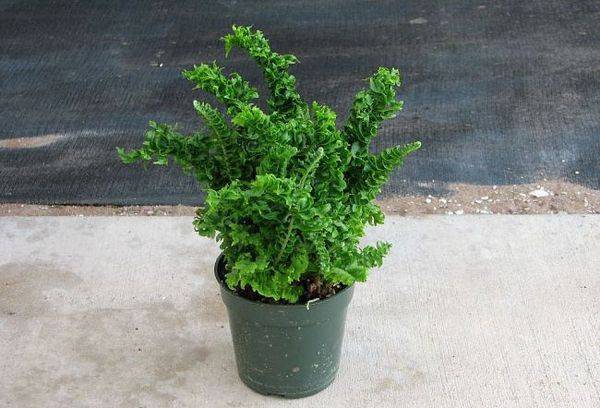
Emin Fern
Tip
If it is not possible to place nephrolepis on the windowsill due to the large amount of light, then place a flowerpot a meter from the window (or further). It will be a good move to place the container on a special stand so that the leaves look as decorative as possible.
In the warmer months, ferns are allowed on the balcony or loggia. In open space, the plant also needs partial shade. The optimum temperature for the maintenance of fern in the summer is + 20-24 degrees. In autumn and winter, nephrolepis should be transferred to a warm room and daylight hours should be controlled: at least 6-7 hours. In winter, the room temperature should not fall below +11 degrees. It is better to maintain it no higher than +15, this is important for the onset of the rest period.

Nephrolepis heart
Humidity, watering, fertilizing
An important point in the care of nephrolepis is the control of air humidity and timely watering. The water used is soft, preferably settled. It will melt or rain. Nefrolepis is watered regularly, leaving the soil slightly moist. The golden mean is respected: the substrate should not completely dry out, but it should not be too wet. In spring, summer and autumn, each subsequent watering is done after the topsoil has dried. With cooling, watering is reduced, but if the flowerpot is in a warm room, then the regime remains the same.
Nephrolepis loves high humidity: it is used to such conditions, growing in tropical and subtropical forests. In rooms with dry air, fern needs light daily spraying. purityis.decorexpro.com/en/ magazine recommends spraying the plant more often in hot weather - up to 3 times a day. It is permissible for Ingoda to take a shower to wash off the dust from the leaves, while covering the soil with plastic bags. In order not to destroy the fern, forgetful gardeners are recommended to place a container of water or wet moss near the flowerpot. Quite often, fern is grown in special closed containers such as an aquarium. In the fall, with the onset of cold weather, spraying should be stopped.
Nephrolepis will be grateful for frequent top dressing. The period for fertilizing begins in early spring and lasts until the fall. In winter, nutrient nutrients cease. Fern needs fertilizer once every 2-3 weeks. For the active development of nephrolepis, alternate organic and mineral products for decorative and deciduous plants, breeding them 4 times less than the specified norm.
Transfer
It is necessary to change the capacity and substrate for young nephrolepis annually, it is enough for an adult plant to move once every 2-3 years. The time for transplanting is the beginning of spring. It is allowed to transplant the plant right after purchase, if the pot is small for him. The relocation procedure activates fern growth.
Nephrolepis loves light acidic soils with sand content. A suitable substrate for growing ferns is usually purchased at a flower shop. To make the soil yourself, you will need:
- peat land
- coniferous land
- sand.
All components are taken in equal parts. It will not be superfluous to add bone meal: for 1 kg of substrate - 5 g. A drainage layer is placed at the bottom of the container. Although the plant loves moisture, stagnation of water in the roots will lead to disease and loss of decorativeness.The bush from the old container is carefully removed with a lump of earth. Transplanting the fern into a new substrate, the root neck is left at the soil level and all voids between the roots are filled.
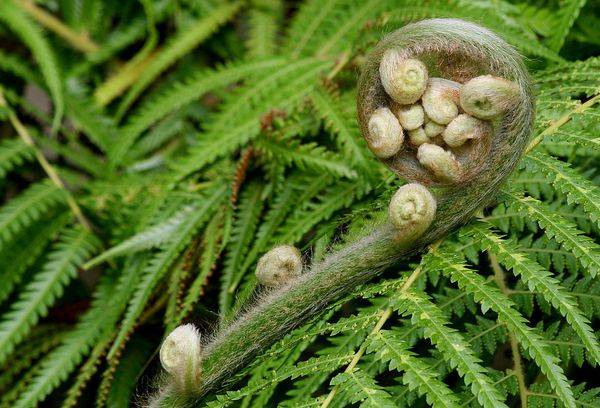
the emergence of new wai Nefrolepis
Breeding
Seedling of ferns in nature occurs through spores. This method is quite time-consuming, since fern rarely forms spores in room conditions. They need to be scraped off from the bottom of the leaf plate, sown in moist peat, cover the pot with polyethylene and placed in a dark place, periodically ventilating and watering. After 2-3 months, shoots will appear. It is necessary to thin them, leaving the strongest, and a month later to pick.
At home, it is easiest to propagate a bush by division or shoots. How to divide the bush:
- In spring, an adult plant is divided into several parts, each of which has growth points.
- Young sockets are separated from the rhizome along with the roots.
- Saplings are placed in separate containers, covered with polyethylene.
- Young ferns are watered, ventilated and stored in a warm place until rooting.
- When the nephrolepses take root, the film needs to be removed and continued to be looked after as usual.
Propagation by shoots:
- In addition to leaves, on the fern you can see a "mustache": these are thin shoots that flower growers use for reproduction.
- The whisker is pressed to the ground surface with a small piece of wire and sprinkled with earth.
- In conditions of constant moisture, young leaves begin to form on the shoot.
- With the appearance of leaves, the shoot is cut off from the mother and transplanted into a separate container.
Growing problems
The troubles sometimes encountered in the process of growing nephrolepis, and methods for eliminating them:
- The leaves turn yellow, the tips turn brown. Old leaves naturally turn yellow and die. Yellowing of young leaves is caused by dry air or pests - mealybug or scale insects. They are destroyed by insecticides. It is necessary to control the humidity of the air, as pests like dryness.
- The leaves turn black and rot. This is a sign of fungal infection. All damaged parts must be removed, the plant treated with fungicide.
- The sheet becomes covered with brown spots, loses color saturation. Perhaps the room is too light, and the plant suffers from an excess of solar energy. You need to move the pot to a shaded place and do not forget about spraying.
- Nephrolepis often begins to dry out due to a lack of light or watering. The tips of the leaves dry with insufficient humidity.
- If the leaves curl and fall, then check the water for chlorine and hardness. Water for irrigation should not be cold. The fern will suffer due to drafts and too low a room temperature.
- Nephrolepis grows poorly. He either lacks nutrients, or it's time to change the pot to a more spacious one.
- Rot is formed due to excess water in the soil. It is necessary to suspend watering and wait for the soil to dry out, and then resume standard care.
Interesting to know
This knowledge will simplify the process of growing nephrolepis and make it fascinating:
- When buying ferns, give preference to a plant aged 2 to 3 years. Young nephrolepses are not yet strong enough to move to a new place of residence, and ferns older than 4 years are more difficult to adapt to new conditions. A successfully selected instance of nephrolepis will take root in the apartment from 1.5 to 2 months.
- In the classification of plants, ferns occupy a whole department, which is divided into many orders and families, not to mention the variety of species and varieties.
- Ferns are ancient plants that inhabited the earth during the time of the dinosaurs. Nephrolepis is most similar to its ancestors.
- The fern is surrounded by many legends and superstitions. It is believed that nephrolepis in the home helps restore harmony and understanding between people with different temperaments.People believe that the plant attracts luck, affects material well-being.
- Another opinion is that nephrolepis is an energy vampire. During growth, it absorbs a large amount of energy.
- The most famous legend about the fern is its flowering on the night of Ivan Kupala. There is a belief that a flower is torn off by an invisible hand of evil spirits, which prevents a person from reaching it. Hence the belief that fern scares away black magic from home. Fading nephrolepis is a sign that witchcraft has been withdrawn from home.
Nephrolepis has not only decorative value. In addition to its beauty and beneficial effects on the room, it has powerful energy. Even a novice can grow this fern, but they are also interested in floriculture professionals, all thanks to the mystery of the plant and its benefits.
